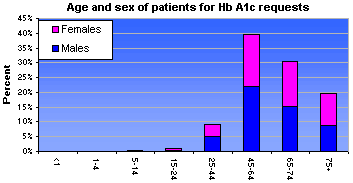Home
Article
Archive
2000 2001
Editor:
Neil Johnston
Columnists:
Rollo
Manning
Leigh Kibby
Jon
Aldous
Roy Stevenson
Brett Clark
Ken Stafford
Pat Gallagher
Heather Pym
Simon
Rudderham
Mark
Coleman
James
Ellerson
Terry
Irvine
Roundup
Peter
Sayers
[Home] [About The Newsletter] [Topics Covered] [Testimonials]
Issue 26 - 5th November 2001
This week:
Diagnostic requests: Part 2 - Pathology
How many GPs order pathology in MD?
Pathology requested in general practice
Types of pathology requests Age-sex of Hb A1c requests
Safer pathology requesting in MDData Updates:
* Allergic rhinitis surveillance
* Top 20 Medications
*The GPRN is a national Australian database of general practice data, provided by participating GPs for research purposes. The data is: anonymous patient management information electronically collected from Medical Director users who have agreed to take part longitudinal with information dating back to 1 Jan 1999 updated on a weekly basisHealth Communication Weekly covers Up-to-date information on current issues in general practice, ways to use Medical Director (MD) more effectively, information on best practice,evidence-based medicine and topics that interest you.
email us at research@hcn.com.au
Click on the Newsletter Reader's Forum link to access a forum from which you can express your comment or viewpoint on this article.
The author values your input, so please take the time to register your details, and participate in the only free debate on the future of Australian pharmacy.
Registration is free, and required once only, for permanent access.
You do not need to register if you only wish to view comments.
Computachem Editor's Note:
We are pleased to announce that we have formed an alliance with Health Communications Network (HCN), an Australian company that is heavily involved in e-health. With permission, we have extracted focus items from their recent newsletter which should prove of interest to pharmacists.
Note that the second item, the top 20 prescriptions written by GP's is provided by the GPRN database noted above.
How many GPs order pathology in MD?
This edition
of HCW investigates the GPRN data for pathology requests made through
Medical Director.
The previous issue focused on imaging requests.
Pathology requests through Medical Director are made more frequently than imaging requests. Data from the GPRN shows that 73% of users made a pathology request through Medical Director during the last week of June 2001, representing an increase from 43% for the same period in 1999. In June 2001, 62% of users made an imaging request in MD.
Pathology requests included the full range of pathology tests including serology, biochemistry, microbiology, cytology.
Rates of pathology requested in general practice
Rates of pathology request encounters appear to have increased over the study period:
* All diagnostic
request encounters – from 100 per 1000 encounters to 200 per 1000 encounters
* Pathology request encounters - from 60 per 1000 encounters to 100 per
1000 encounters * Hb A1c request encounters – from 2-3 per 1000 encounters
to 4-6 per 1000 encounters.
However the apparent increase is due to the increased use of the pathology request functionality by users of Medical Director.
GPRN data allows a more detailed picture of pathology requests in Australian general practice than that available in previous studies (1). The data in the GPRN is the full actual request (anonymous – primary source).
1. Britt H, Miller GC, McGeechan K, Sayer GP. Pathology ordering by general practitioners in Australia 1998. AIHW Cat. No. GEP 4. Canberra: Department of Health and Ages Care (General Practice Series No. 4).
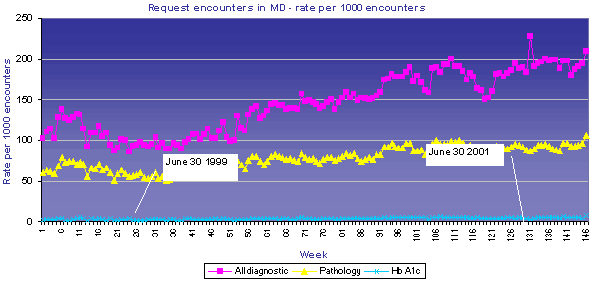
|
Types of pathology requests A breakdown
of pathology request types from the GPRN is shown in Table 1 A request for FBE is the most common pathology request made, accounting for 23.9% of all pathology requests (Table 1). E/LFTs (11.5%) and ESR (9.9%) are the next most frequent pathology requests, while Pap smear/cervical cytology request accounted for 4.6% of all pathology requests through GPRN. The 20 most frequent pathology requests account for 92.8% of all pathology requests. Age-sex distribution of Hb A1c requests HbA1c requests are a standard indicator in diabetes management. The age-sex distribution of the patients for whom requests were made for the period 1 July, 2000 to 30 June, 2001 shows that the majority of Hb A1c request are for patients aged 45-64. (Figure 2) There is a slightly higher rate for male patients than female patients.
|
Table
1: Pathology request
|
Safer pathology requesting in MD
Even with
the advances brought by electronic management, a good system is vital.
Prior to the computerisation of general practice, management of tests
and investigations was identified as a potentially high risk area for
mishaps.
Problems identified include: lost or misfiled test results, patients not
informed of follow-up, missing results, no record of actions taken after
diagnostics.(2,3)
Margaret
Windsor, from DARTA, has been training GPs in MD for the past 4 years.
She emphasises that "MD provides Doctors and support staff with the
tools necessary to audit the flow of pathology from the time of request
up to the final step of ensuring that all results have been come back
in.
"It is important that each practice sets up management systems and protocols for each of these steps."
Margaret uses the flow chart below to demonstrate functions within MD used in the cycle of ordering, reviewing, recording and acting on pathology. The boxes outside the circle highlight issues for practices to consider in their own system.
2. Bhasale A, Miller G, Britt H, Reid S. Aust Fam Physician 1996 Dec;25(12):1861-3 Clinical incidents in general practice. Keeping on track with test results. 3. Bhasale A, Norton KJ, Britt H. Tests and investigations. Indicators for better utilisation. Aust Fam Physician 1996 May;25(5):680-7
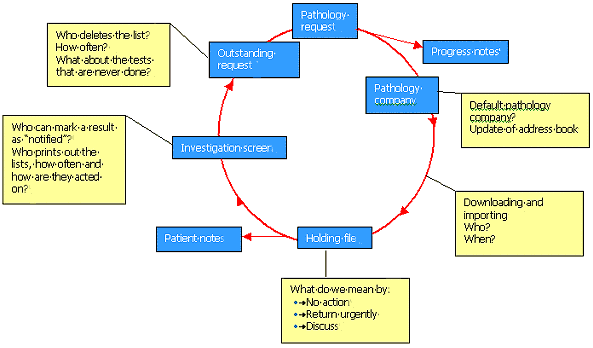
The outstanding request window
Main Menu
> Files > Outstanding Requests
As an example, lets look at the Outstanding Request window.
The outstanding request screen maintains a list of all requests made in MD. They will remain in the list until they are manually deleted. To maintain a list of requests that have not been received, it could be part of your system to delete requests from this window once they have been received, checked, and acted upon.
To check which results have already been added to the patient’s record, click the search button.
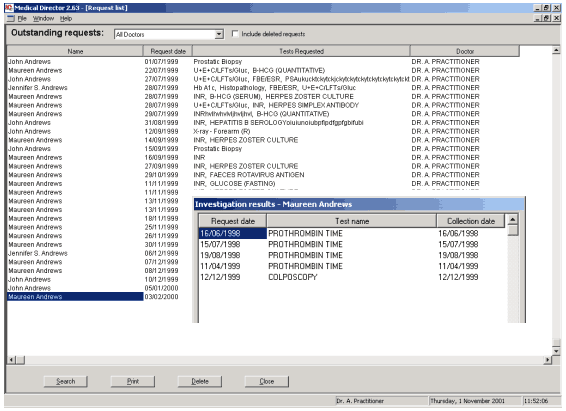
Allergic rhinitis surveillance
The chart
below shows the rate of Allergic Rhinitis visits per 1000 up till 28 October
2001.
A visit
for Allergic Rhinitis is considered to have taken place if the GP has
recorded either Allergic Rhinitis or hay fever as a diagnosis or has prescribed
either Mometasone nasal spray or Ipratropium nasal spray. These two products
were chosen as their indications are specifically Allergic Rhinitis and
not other Allergic conditions. Part of the challenge of attempting surveillance
of this condition is that a large proportion of the treatments are available
as over-the-counter preparations. Nevertheless it is reasonable to assume
that for those patients requiring more aggressive therapy, GPRN data should
reflect the seasonal nature of the condition.
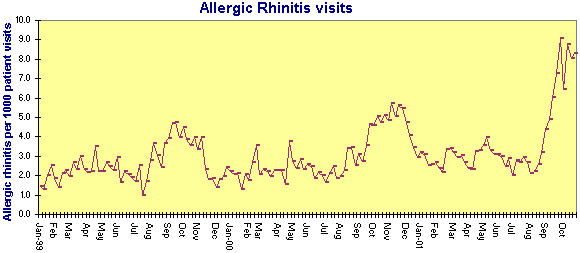
Top 20
Medications prescribed in General Practice this week
(weighted by no of repeats)
| This month | Last month | This year | ||||
| Generic medication | Rank | Percent | Rank | Percent | Rank | Percent |
| Salbutamol Sulfate | 1 | 3.05 | 1 | 3.07 | 1 | 3.11 |
| Atorvastatin | 2 | 2.69 | 2 | 2.43 | 3 | 2.47 |
| Simvastatin | 3 | 2.61 | 3 | 2.37 | 2 | 2.53 |
| Paracetamol | 4 | 2.1 | 4 | 2.22 | 6 | 2.08 |
| Celecoxib | 5 | 1.89 | 5 | 1.95 | 5 | 2.27 |
| Ranitidine Hydrochloride | 6 | 1.83 | 8 | 1.76 | 4 | 2.28 |
| Atenolol | 7 | 1.65 | 9 | 1.72 | 7 | 1.73 |
| Omeprazole Magnesium | 8 | 1.65 | 7 | 1.81 | 13 | 1.29 |
| FluticasonePropionate/ Salmeterol Xinafoate |
9 | 1.64 | 15 | 1.32 | 20 | 1.02 |
| Amoxycillin | 10 | 1.57 | 6 | 1.88 | 12 | 1.37 |
| Levonorgestrel/ Ethinyloestradiol |
11 | 1.47 | 10 | 1.49 | 8 | 1.53 |
| Rofecoxib | 12 | 1.43 | 11 | 1.42 | 22 | 0.92 |
| Irbesartan | 13 | 1.3 | 13 | 1.38 | 10 | 1.39 |
| Metformin Hydrochloride | 14 | 1.3 | 12 | 1.41 | 14 | 1.25 |
| Sertraline Hydrochloride | 15 | 1.28 | 16 | 1.3 | 9 | 1.45 |
| Paracetamol/ Codeine Phosphate |
16 | 1.28 | 14 | 1.36 | 11 | 1.38 |
| Amlodipine Besylate | 17 | 1.23 | 18 | 1.22 | 15 | 1.23 |
| Ramipril | 18 | 1.17 | 20 | 1.15 | 19 | 1.04 |
| Methadone | 19 | 1.13 | 17 | 1.25 | 41 | 0.73 |
| Budesonide | 20 | 1.11 | 24 | 1.03 | 18 | 1.09 |
This month = four weeks ending 28 October 2001
Last month = four weeks ending 30 Sept 2001
This year = 29 October 2000 to 28 October 2001
Last data supplied: 28 October 2001
Data source: GPRN Health Communication Network
Editorial
Review:
Geoffrey Sayer * Dr Frank Pyefinch
Contributing Authors:
Fiona Horn * Leigh Hendrie * Kevin McGeechan * Geoffrey Sayer
Editor:
Alice Bhasale
Health Communication Network, PO Box 67 St Leonards NSW 1590 ph 02 9906
6633
email: research@hcn.com.au.
PLEASE COMPLETE OUR SURVEY (WHICH HAS A LIFE OF 10 DAYS ONLY), AND WHICH CAN BE FOUND BY FOLLOWING THIS LINK: http://www.zoomerang.com/survey.zgi?9B0V7DDMS0LM6LHD5VQBK6BY
(N.B If the link fails to operate, please copy and paste the link to your browser URL address panel and press return. This will clear any faults.)
Back
to Article Index
Newsletter
Reader's Forum
The comments and views expressed in the above article are those of the author and no other. The author welcomes any comment and interaction, directly or via the Newsletter Reader's Forum links located at the top and bottom of each article.
The newsletter archives are now fully searchable via the search engine on the left hand side of this page. If you would like to find similar articles to the above material, please enter the appropriate keyword(s). To retain context with multiple keywords or phrases, please enclose in inverted commas.
Please contact us if you would like further information or would like us to research additional material to publish as future articles.
Don't forget to advise of any change in your e-mail address so that your subscription may be continued without interruption.
Letters to the editor are encouraged, or if you have material you would like published, please forward to the editor.
Any interested persons who would like to receive this free newsletter on their desktop each fortnight, please send a single word e-mail "Subscribe"*
If you have found value in this newsletter, please share it with a friend, or alternatively, encourage a colleague to subscribe
neilj@computachem.com.au
Why not try (and bookmark) the
Computachem Interweb Directory
for an easily accessed range of medical and pharmacy links, plus a host of pharmacy relevant links.
The directory also contains a very fast search engine for Internet enquiries. You may also access the Home Page at:
http://www.computachem.com.au

